1999 ISRS survey relates U.S. trends in refractive surgery
Survey shows RK and PRK are on the decline, while LASIK is on the rise in total volume of procedures.
The 1999 refractive surgery survey was mailed to more than 900 U.S. International Society of Refractive Surgery (ISRS) members in September 1999 with 317 responses received by mid-October, representing 33% of the U.S. ISRS membership. The purpose of this survey was to determine the frequency of various refractive surgical procedures in the United States by ISRS members including: radial keratotomy (RK), photorefractive keratectomy (PRK), laser in situ keratomileusis (LASIK), intracorneal rings, laser thermokeratoplasty (LTK), clear lens extraction and phakic IOLs. Surgeon preference of refractive procedures in specific patients, choice of corneal topographers, microkeratomes, excimer lasers and practice patterns were compared with previous years’ surveys in 1997 and 1998.
RK and PRK were on the decline as noted in Figure 1, while LASIK was on the rise in total volume of procedures compared with 2 years ago. Less than 1% of respondents were performing 25 or more RK or PRK procedures per month, but 45% were performing this volume of LASIK, up from 31% in 1998 and 15% in 1997. Less than 1% of surgeons were performing greater than 75 cases per month of either RK or PRK versus 16% for LASIK at that rate, up from 13% in 1998 and 5% in 1997.
Procedure preference (Figure 2) among surgeons for low myopia (3 D) in a 30 year old was 2% performing RK, 4% PRK, 5% intracorneal rings and 88% LASIK. The procedure of choice for moderate myopia (7 D) was 0%, 1% and 99%, respectively, for RK, PRK and LASIK. The procedure of choice for high myopia (12 D) was 0% RK, 1% PRK and 61% LASIK. Twenty-six percent of surgeons preferred waiting on high myopes for a better surgical option, compared with 21% in 1998 and 15% in 1997.
The procedure of choice (Figure 3) among ISRS surgeons for the 45-year-old +1 D hyperope was 2% PRK, 4% LTK, 70% LASIK and 24% waiting for better surgical options. For the same 45-year-old +3 D hyperope, 1% chose PRK, 86% chose LASIK and 13% chose to wait. For the +5 D 45-year-old hyperope, 20% chose clear lens extraction, 32% LASIK and 49% elected to wait for better surgical alternatives.
Figure 4 notes the acceptability of bilateral simultaneous refractive surgery among survey respondents. Of surgeons doing PRK, 47% stated they sometimes or always do both eyes in the same surgical setting (down from 50% in 1998) versus 94% for LASIK (up from 83% in 1998) and 64% for intracorneal rings (not surveyed in 1998). As a measure of personal overall acceptance of various refractive surgical procedures, the ISRS members were asked if they had at any time in the past undergone specific refractive surgeries (Figure 5). It is interesting to note that in the 3 years that the excimer laser has been available in the United States, 11% of the ISRS survey respondents have had LASIK surgery performed on their own eyes, compared with less than 1% of the general population.
Equipment preferences
Equipment preferences were again asked in the 1999 survey. Regarding corneal topographers (Figure 6), the EyeSys (Irvine, Calif.) unit was primarily used by 36% of respondents, compared with 24% for Tomey (Waltham, Mass.), 18% for Humphrey Systems (Dublin, Calif.) and 8% for Orbscan (Bausch & Lomb Surgical, Claremont, Calif.). Figure 7 notes excimer laser preferences with the Visx (Santa Clara, Calif.) laser being primarily used by 81% of respondents, 18% for Summit (Waltham, Mass.) and 1% for Nidek (Fremont, Calif.), compared with the 1998 survey results of 74%, 24% and 0%, respectively. Microkeratome preferences (Figure 8) noted that the Bausch & Lomb Hansatome was primarily used by 56% of respondents, the Automated Corneal Shaper (Bausch & Lomb) by 19%, Moria (Antony, France) LSK by 9%, Moria C-B by 9%, Innovatome (Innovative Optics, Albuquerque, N.M.) by 4% and 2% for all other microkeratomes.
Overall, there was a declining interest in RK and PRK, with an increasing interest in LASIK, intracorneal rings, LTK, clear lens extraction and phakic IOL surgery in 1999. LASIK has become the refractive procedure of choice among ISRS U.S. surgeons, with high-volume refractive surgeons performing primarily LASIK. Bilateral simultaneous surgery is further increasing in acceptance and is preferred for LASIK, more so than PRK. Finally, the Visx Star laser is preferred 4:1 over the Summit and all other lasers, and the Bausch & Lomb Hansatome has become the gold standard with LASIK surgeons in 1999.
Figure 1: > 5 cases/month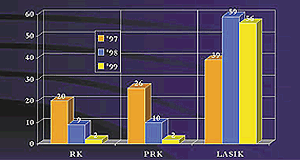 |
Figure 2: preferred surgery for 30 y.o. -3 D myope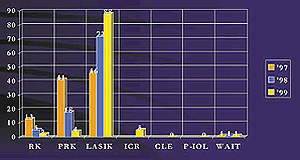 |
Figure 3: preferred surgery for 45 y.o. +1 D myope 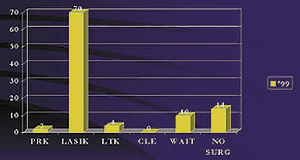 |
Figure 4: bilateral surgery performed at same visit 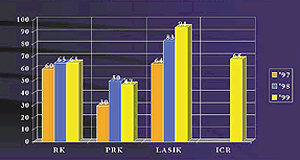 |
Figure 5: procedures performed on ISRS members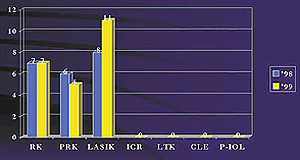 |
Figure 6: most commonly used topography unit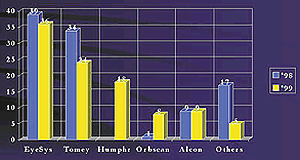 |
Figure 7: most commonly used excimer laser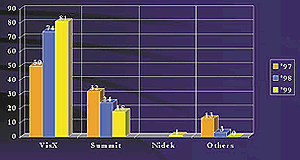 |
Figure 8: most commonly used microkeratome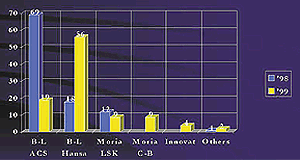 |
For Your Information:
- Richard J. Duffey, MD, can be reached at 2880 Dauphin St., Mobile, AL 36606-2494; (334) 473-1900; fax: (334) 470-8802. Dr. Duffey has no direct financial interest in any of the products mentioned in this article, nor is he a paid consultant for any companies mentioned.
